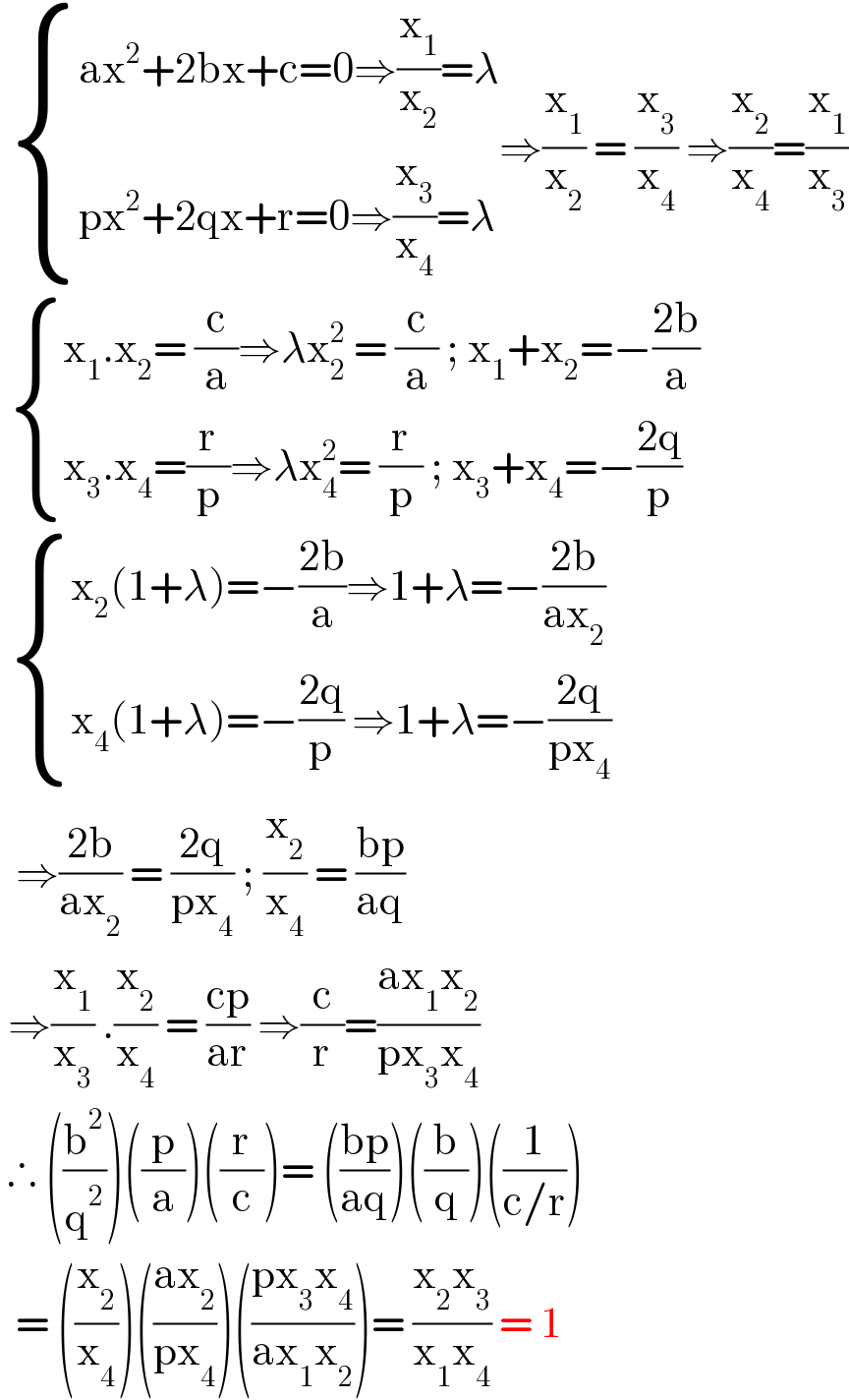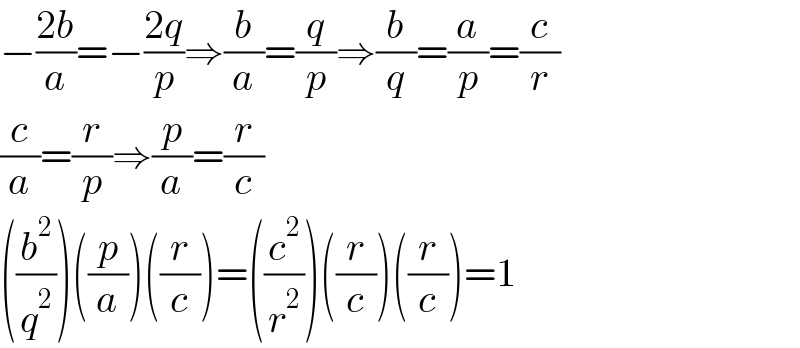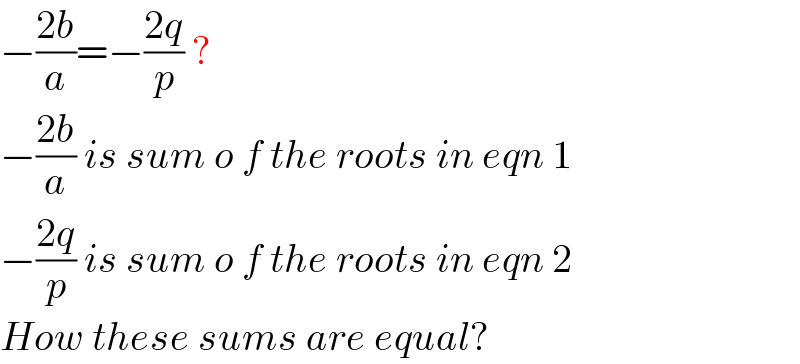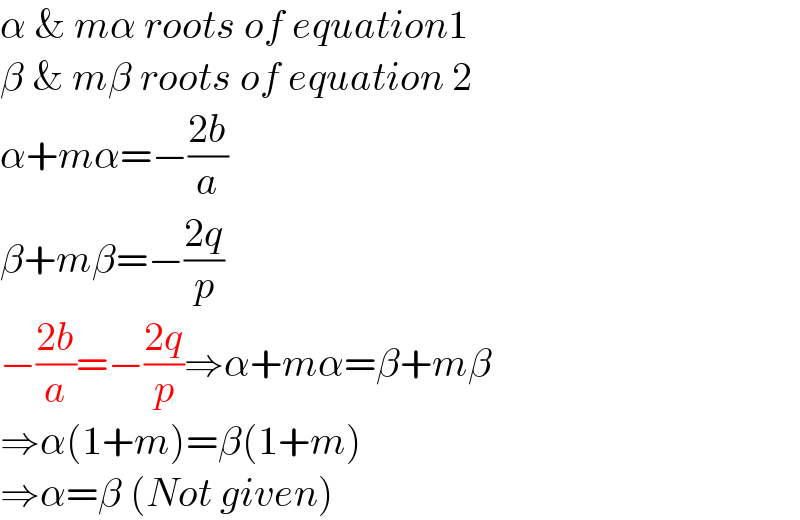
Question Number 162165 by cortano last updated on 27/Dec/21

$$\mathrm{If}\:\mathrm{the}\:\mathrm{ratio}\:\mathrm{of}\:\mathrm{the}\:\mathrm{roots}\:\mathrm{of}\:\mathrm{equation} \\ $$$$\:{ax}^{\mathrm{2}} +\mathrm{2}{bx}+{c}=\mathrm{0}\:\mathrm{is}\:\mathrm{same}\:\mathrm{as}\:\mathrm{the}\:\mathrm{ratio} \\ $$$$\:\mathrm{of}\:\mathrm{the}\:\mathrm{roots}\:\mathrm{of}\:{px}^{\mathrm{2}} +\mathrm{2}{qx}+{r}=\mathrm{0}\:\mathrm{where} \\ $$$$\:{a},{b},{c},{p}\:,{r}\:\mathrm{are}\:\mathrm{non}\:\mathrm{zero}\:\mathrm{real}\:\mathrm{numbers} \\ $$$$.\:\mathrm{Then}\:\mathrm{the}\:\mathrm{value}\:\mathrm{of}\:\left(\frac{{b}^{\mathrm{2}} }{{q}^{\mathrm{2}} }\right)\left(\frac{{p}}{{a}}\right)\left(\frac{{r}}{{c}}\right)\:\mathrm{is}\:\mathrm{equal}\:\mathrm{to} \\ $$$$\: \\ $$
Commented by bobhans last updated on 27/Dec/21

$$\:\begin{cases}{\mathrm{ax}^{\mathrm{2}} +\mathrm{2bx}+\mathrm{c}=\mathrm{0}\Rightarrow\frac{\mathrm{x}_{\mathrm{1}} }{\mathrm{x}_{\mathrm{2}} }=\lambda}\\{\mathrm{px}^{\mathrm{2}} +\mathrm{2qx}+\mathrm{r}=\mathrm{0}\Rightarrow\frac{\mathrm{x}_{\mathrm{3}} }{\mathrm{x}_{\mathrm{4}} }=\lambda}\end{cases}\Rightarrow\frac{\mathrm{x}_{\mathrm{1}} }{\mathrm{x}_{\mathrm{2}} }\:=\:\frac{\mathrm{x}_{\mathrm{3}} }{\mathrm{x}_{\mathrm{4}} }\:\Rightarrow\frac{\mathrm{x}_{\mathrm{2}} }{\mathrm{x}_{\mathrm{4}} }=\frac{\mathrm{x}_{\mathrm{1}} }{\mathrm{x}_{\mathrm{3}} } \\ $$$$\:\begin{cases}{\mathrm{x}_{\mathrm{1}} .\mathrm{x}_{\mathrm{2}} =\:\frac{\mathrm{c}}{\mathrm{a}}\Rightarrow\lambda\mathrm{x}_{\mathrm{2}} ^{\mathrm{2}} \:=\:\frac{\mathrm{c}}{\mathrm{a}}\:;\:\mathrm{x}_{\mathrm{1}} +\mathrm{x}_{\mathrm{2}} =−\frac{\mathrm{2b}}{\mathrm{a}}}\\{\mathrm{x}_{\mathrm{3}} .\mathrm{x}_{\mathrm{4}} =\frac{\mathrm{r}}{\mathrm{p}}\Rightarrow\lambda\mathrm{x}_{\mathrm{4}} ^{\mathrm{2}} =\:\frac{\mathrm{r}}{\mathrm{p}}\:;\:\mathrm{x}_{\mathrm{3}} +\mathrm{x}_{\mathrm{4}} =−\frac{\mathrm{2q}}{\mathrm{p}}}\end{cases} \\ $$$$\:\begin{cases}{\mathrm{x}_{\mathrm{2}} \left(\mathrm{1}+\lambda\right)=−\frac{\mathrm{2b}}{\mathrm{a}}\Rightarrow\mathrm{1}+\lambda=−\frac{\mathrm{2b}}{\mathrm{ax}_{\mathrm{2}} }}\\{\mathrm{x}_{\mathrm{4}} \left(\mathrm{1}+\lambda\right)=−\frac{\mathrm{2q}}{\mathrm{p}}\:\Rightarrow\mathrm{1}+\lambda=−\frac{\mathrm{2q}}{\mathrm{px}_{\mathrm{4}} }}\end{cases} \\ $$$$\:\:\Rightarrow\frac{\mathrm{2b}}{\mathrm{ax}_{\mathrm{2}} }\:=\:\frac{\mathrm{2q}}{\mathrm{px}_{\mathrm{4}} }\:;\:\frac{\mathrm{x}_{\mathrm{2}} }{\mathrm{x}_{\mathrm{4}} }\:=\:\frac{\mathrm{bp}}{\mathrm{aq}} \\ $$$$\:\Rightarrow\frac{\mathrm{x}_{\mathrm{1}} }{\mathrm{x}_{\mathrm{3}} }\:.\frac{\mathrm{x}_{\mathrm{2}} }{\mathrm{x}_{\mathrm{4}} }\:=\:\frac{\mathrm{cp}}{\mathrm{ar}}\:\Rightarrow\frac{\mathrm{c}}{\mathrm{r}}=\frac{\mathrm{ax}_{\mathrm{1}} \mathrm{x}_{\mathrm{2}} }{\mathrm{px}_{\mathrm{3}} \mathrm{x}_{\mathrm{4}} } \\ $$$$\:\therefore\:\left(\frac{\mathrm{b}^{\mathrm{2}} }{\mathrm{q}^{\mathrm{2}} }\right)\left(\frac{\mathrm{p}}{\mathrm{a}}\right)\left(\frac{\mathrm{r}}{\mathrm{c}}\right)=\:\left(\frac{\mathrm{bp}}{\mathrm{aq}}\right)\left(\frac{\mathrm{b}}{\mathrm{q}}\right)\left(\frac{\mathrm{1}}{\mathrm{c}/\mathrm{r}}\right) \\ $$$$\:\:=\:\left(\frac{\mathrm{x}_{\mathrm{2}} }{\mathrm{x}_{\mathrm{4}} }\right)\left(\frac{\mathrm{ax}_{\mathrm{2}} }{\mathrm{px}_{\mathrm{4}} }\right)\left(\frac{\mathrm{px}_{\mathrm{3}} \mathrm{x}_{\mathrm{4}} }{\mathrm{ax}_{\mathrm{1}} \mathrm{x}_{\mathrm{2}} }\right)=\:\frac{\mathrm{x}_{\mathrm{2}} \mathrm{x}_{\mathrm{3}} }{\mathrm{x}_{\mathrm{1}} \mathrm{x}_{\mathrm{4}} }\:=\:\mathrm{1} \\ $$
Answered by Rasheed.Sindhi last updated on 27/Dec/21

$${Let}\:{the}\:{roots}\:{of}\:\:{ax}^{\mathrm{2}} +\mathrm{2}{bx}+{c}=\mathrm{0} \\ $$$${are}\:\alpha\:\:{m}\alpha. \\ $$$${the}\:{roots}\:{of}\:{px}^{\mathrm{2}} +\mathrm{2}{qx}+{r}=\mathrm{0}\:{are} \\ $$$$\:\beta\:,\:{m}\beta \\ $$$$\bullet\alpha+{m}\alpha=−\frac{\mathrm{2}{b}}{{a}}\:\:,\:{m}\alpha^{\mathrm{2}} =\frac{{c}}{{a}} \\ $$$$\:\:\:\alpha=−\frac{\mathrm{2}{b}}{\left(\mathrm{1}+{m}\right){a}},\:{m}\left(−\frac{\mathrm{2}{b}}{\left(\mathrm{1}+{m}\right){a}}\right)^{\mathrm{2}} =\frac{{c}}{{a}} \\ $$$$\bullet\beta+{m}\beta=−\frac{\mathrm{2}{q}}{{p}}\:,\:{m}\beta^{\mathrm{2}} =\frac{{r}}{{p}} \\ $$$$\:\:\:\:\beta=−\frac{\mathrm{2}{q}}{\left(\mathrm{1}+{m}\right){p}},{m}\left(−\frac{\mathrm{2}{q}}{\left(\mathrm{1}+{m}\right){p}}\right)^{\mathrm{2}} =\frac{{r}}{{p}} \\ $$$$\frac{\:\cancel{{m}}\left(−\frac{\mathrm{2}{b}}{\left(\mathrm{1}+{m}\right){a}}\right)^{\mathrm{2}} }{\cancel{{m}}\left(−\frac{\mathrm{2}{q}}{\left(\mathrm{1}+{m}\right){p}}\right)^{\mathrm{2}} }=\frac{\frac{{c}}{{a}}}{\frac{{r}}{{p}}} \\ $$$$\frac{\:\frac{\mathrm{4}{b}^{\mathrm{2}} }{\left(\mathrm{1}+{m}\right)^{\mathrm{2}} {a}^{\mathrm{2}} }}{\frac{\mathrm{4}{q}^{\mathrm{2}} }{\left(\mathrm{1}+{m}\right)^{\mathrm{2}} {p}^{\mathrm{2}} }}=\frac{{cp}}{{ar}} \\ $$$$\frac{\mathrm{4}{b}^{\mathrm{2}} }{{a}^{\mathrm{2}} }×\frac{{p}^{\mathrm{2}} }{\mathrm{4}{q}^{\mathrm{2}} }=\frac{{cp}}{{ar}} \\ $$$$\frac{{b}^{\mathrm{2}} {p}}{{aq}^{\mathrm{2}} }=\frac{{c}}{{r}}\Rightarrow\left(\frac{{b}^{\mathrm{2}} }{{q}^{\mathrm{2}} }\right)\left(\frac{{p}}{{a}}\right)\left(\frac{{r}}{{c}}\right)=\frac{{c}}{{r}}\left(\frac{{r}}{{c}}\right)=\mathrm{1} \\ $$$$\left(\frac{{b}^{\mathrm{2}} }{{q}^{\mathrm{2}} }\right)\left(\frac{{p}}{{a}}\right)\left(\frac{{r}}{{c}}\right)=\mathrm{1} \\ $$
Answered by Ar Brandon last updated on 27/Dec/21

$$−\frac{\mathrm{2}{b}}{{a}}=−\frac{\mathrm{2}{q}}{{p}}\Rightarrow\frac{{b}}{{a}}=\frac{{q}}{{p}}\Rightarrow\frac{{b}}{{q}}=\frac{{a}}{{p}}=\frac{{c}}{{r}} \\ $$$$\frac{{c}}{{a}}=\frac{{r}}{{p}}\Rightarrow\frac{{p}}{{a}}=\frac{{r}}{{c}} \\ $$$$\left(\frac{{b}^{\mathrm{2}} }{{q}^{\mathrm{2}} }\right)\left(\frac{{p}}{{a}}\right)\left(\frac{{r}}{{c}}\right)=\left(\frac{{c}^{\mathrm{2}} }{{r}^{\mathrm{2}} }\right)\left(\frac{{r}}{{c}}\right)\left(\frac{{r}}{{c}}\right)=\mathrm{1} \\ $$
Commented by Rasheed.Sindhi last updated on 27/Dec/21

$$−\frac{\mathrm{2}{b}}{{a}}=−\frac{\mathrm{2}{q}}{{p}}\:? \\ $$$$−\frac{\mathrm{2}{b}}{{a}}\:{is}\:{sum}\:{o}\:{f}\:{the}\:{roots}\:{in}\:{eqn}\:\mathrm{1} \\ $$$$−\frac{\mathrm{2}{q}}{{p}}\:{is}\:{sum}\:{o}\:{f}\:{the}\:{roots}\:{in}\:{eqn}\:\mathrm{2} \\ $$$${How}\:{these}\:{sums}\:{are}\:{equal}? \\ $$
Commented by Ar Brandon last updated on 28/Dec/21
Thank you, Sir �� But I think my friend Dwaipayan Shikari was the most outstanding amongst we, the young members. I'm missing him already ���� He's been offline for a very long time even on telegram. He really motivated me a lot.
Commented by Ar Brandon last updated on 28/Dec/21

$$\mathrm{I}\:\mathrm{love}\:\mathrm{the}\:\mathrm{way}\:\mathrm{you}\:\mathrm{often}\:\mathrm{design}\:\mathrm{your}\:\mathrm{text},\:\mathrm{Sir}. \\ $$$$\mathcal{E}.{g}.\:\mathbb{T}\mathrm{han}\mathbb{K}\mathrm{s}\:\mathcal{S}{ir}! \\ $$🤭
Commented by Rasheed.Sindhi last updated on 28/Dec/21

$$\alpha\:\&\:{m}\alpha\:{roots}\:{of}\:{equation}\mathrm{1} \\ $$$$\beta\:\&\:{m}\beta\:{roots}\:{of}\:{equation}\:\mathrm{2} \\ $$$$\alpha+{m}\alpha=−\frac{\mathrm{2}{b}}{{a}} \\ $$$$\beta+{m}\beta=−\frac{\mathrm{2}{q}}{{p}} \\ $$$$−\frac{\mathrm{2}{b}}{{a}}=−\frac{\mathrm{2}{q}}{{p}}\Rightarrow\alpha+{m}\alpha=\beta+{m}\beta \\ $$$$\Rightarrow\alpha\left(\mathrm{1}+{m}\right)=\beta\left(\mathrm{1}+{m}\right) \\ $$$$\Rightarrow\alpha=\beta\:\left({Not}\:{given}\right) \\ $$
Commented by Ar Brandon last updated on 28/Dec/21
����
Commented by Rasheed.Sindhi last updated on 28/Dec/21

$$\boldsymbol{\alpha}{r}\:\boldsymbol{\beta}{randon}\:{sir},{am}\:{I}\:{wrong}? \\ $$
Commented by Ar Brandon last updated on 28/Dec/21
I'm not good enough ����
Commented by Rasheed.Sindhi last updated on 28/Dec/21

$${You}'{re}\:{more}\:{than}\:{enough}\:{good}\:{at} \\ $$$${your}\:{early}\:{stage}\:{of}\:{your}\:{life}!\:\mathcal{T}{his} \\ $$$$\:{I}\:{say}\:{on}\:{the}\:{basis}\:{of}\:{your}\:{sent}\:{posts}. \\ $$$$\left({I}\:{recall}\:{that}\:{you}\:{are}\:{one}\:{of}\:{some}\right. \\ $$$${youngest}\:{forum}-{friends}.{I}'{m}\:{your} \\ $$$$\left.{opposite}\:{in}\:{age}\:{as}\:{well}\:{as}\:{knowledge}.\right) \\ $$$${May}\:{God}\:{brightens}\:{your}\:{future}! \\ $$
Commented by Rasheed.Sindhi last updated on 28/Dec/21

$$\mathcal{N}{o}\:{doubt}\:{Shikari}\:{was}\:{also}\:{outstanding} \\ $$$${and}\:{I}\:{also}\:{miss}\:{him}.\mathcal{T}{hank}\:{you}\:{for} \\ $$$${conversation}! \\ $$$$\mathcal{BTW}\:{how}\:{did}\:{you}\:{bring}\:{this}\:{emoji} \\ $$$${in}\:{a}\:{comment}\:{written}\:{by}\:{forum} \\ $$$${keyboard}? \\ $$
Commented by Ar Brandon last updated on 28/Dec/21
��
Commented by Ar Brandon last updated on 28/Dec/21
I clicked on line matrix then " insert plain text"
Commented by Rasheed.Sindhi last updated on 28/Dec/21

$$\mathcal{T}{hank}\:{you}\:{Ar}\:{Brandon}!\: \\ $$👍👍👍😃
Commented by Ar Brandon last updated on 28/Dec/21

🙃cool
